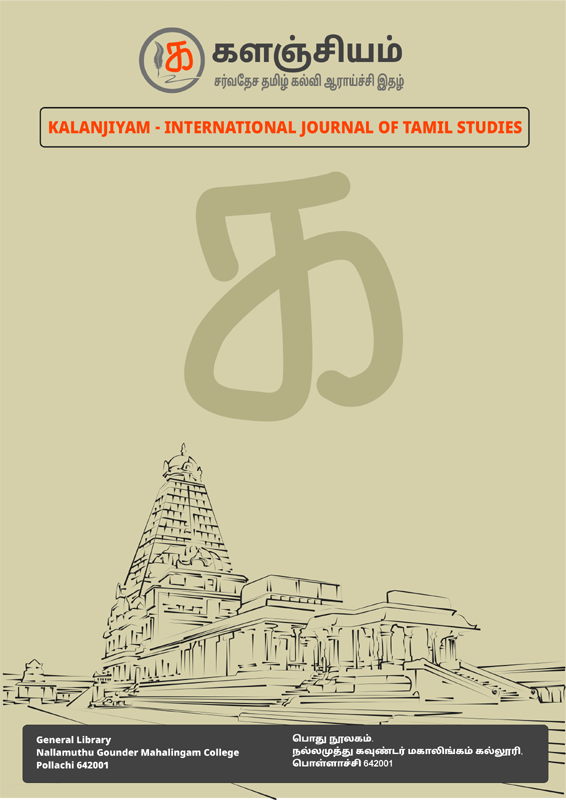மொழிபெயர்ப்பின் முக்கிய விதிகள் மற்றும் இன்றியமையாப் பண்புகள்
Basic rules and essential characteristics of translation
Keywords:
மொழிபெயர்ப்பின் முக்கிய விதிகள், Translation, Tamil Language, SanskritAbstract
பதினொட்டாம், பத்தொன்பதாம் நூற்றாண்டின் தொடக்கத்தில் வளர்ச்சிநிலை எட்டிய மொழிபெயர்ப்பு வளர்ச்சிநிலையை பெயர்த்து முதன் முதலில் பள்ளிகளுக்கு தேவையான நூல்களை மட்டும் தமிழ்மொழியில் தரும் நிலையில் அடியெடுத்து வைத்தன. 19 ஆம் நூற்றாண்டின் இடையில் ஆங்கில மொழி வளர்ச்சிநிலையில் பள்ளி மாணவர்களிடையே தமிழ்ப்பாடம் தவிர்த்து ஏனைய பாடங்களை ஆங்கிலமொழியில் படிக்கும் சூழ்நிலை உருவனதால் மொழிபெயர்ப்புப் பணி தொய்வு நிலையினை அடைந்தன. 20 ஆம் நூற்றாண்டின் தொடக்கத்திலேயே அவரவர் தாய்மொழியில் பள்ளிக்கல்வியை பயில வேண்டும் என்ற நோக்கத்தினால் மொழிபெயர்ப்பு பணியானது மீண்டும் வளர்ச்சிநிலையினை பெற துவங்கின. இதனால் அனைத்து துறை ஆராய்ச்சி முடிவுகள், கட்டுரைகள், புதியக் கண்டுபிடிப்புகள், வேளாண் தொழில்நுட்பங்கள், அறிவியல் தொழில்நுட்பங்களை அறிந்து கொள்ளும் விதமாக தமிழ் மொழியிலேயே மொழிபெயர்த்து தர வேண்டிய அவசியத்தின் தேவைக் கருதி மொழிபெயர்ப்புப் பணியில் கவனம் செலுத்தப்பட்டது. இரண்டாயிரமாண்டுக் காலமாகப் பாலி, பிராகிருதம், சமஸ்கிருதம் போன்ற மொழிகளிலிருந்து தமிழில் மொழிபெயர்க்கப்பட்ட முயற்சிகள், கருத்து நிலையில் அமைந்தனவாகும். ஒரு நூலினை வரிக்குவரி முழுமையாக மொழிபெயர்ப்பது, மேலை நாட்டவரின் பெயர்ப்புடன் தொடங்குகின்றன.
In the early 18th and 19th centuries, translation efforts advanced significantly, initially focusing on producing essential textbooks for Tamil-language schools. However, by the mid-19th century, the rise of English education led to a decline in translation activities, as students began studying various subjects in English alongside Tamil. As the 20th century dawned, the translation effort revived, driven by the desire for education in one's native language. This resurgence highlighted the importance of translating research findings, articles, innovations, agricultural advancements, and scientific knowledge into Tamil. Over the past two millennia, attempts to translate texts from languages like Pali, Prakrit, and Sanskrit have remained largely theoretical. True verbatim translation begins with a deep understanding of the source language, ideally from a native perspective.
Downloads
References
பேரா. கா. பட்டாபிராமன், மொழிபெயர்ப்புக் கலை, பக். 1, 134, நியூசெஞ்சுரி புக் ஹவுஸ் (பி)லிட், 2005, சென்னை.
முனைவர் ந. அரணமுறுவல், தமிழும் மொழிபெயர்ப்பு முறைகளும், பக். 103, பாவை பப்ளிகேஷன்ஸ், 2005, சென்னை.
பேரா. டாக்டர் ரா. சீனிவாசன், மொழியியல், பக். 3, முல்லை நிலையம் , சென்னை.
மு. வளர்மதி, மொழிபெயர்ப்புக் கலை, பக். 54, திருமகள் நிலையம், 2003, சென்னை.
K.V.V.L NARASIMHA RAO, ASPECTS OF TRANSLATION, PAGE. 42, CENTRAL INSTITUTE OF INDIAN LANGUAGES, 2005, MYSORE
Downloads
Published
Issue
Section
License
Copyright (c) 2024 முனைவர் த. சமுத்திரராஜ் தமிழ் பேராசிரியர் (Author)

This work is licensed under a Creative Commons Attribution 4.0 International License.
Our journal adopts CC BY License Creative Commons Attribution 4.0 International License http://Creativecommons.org//license/by/4.0/ . It allows using, reusing, distributing and reproducing of the original work with proper citation.


